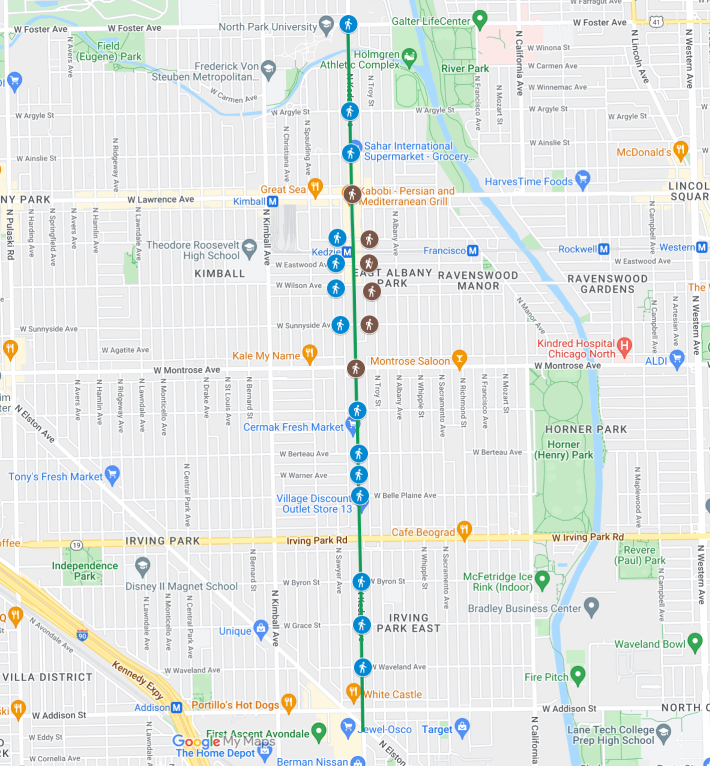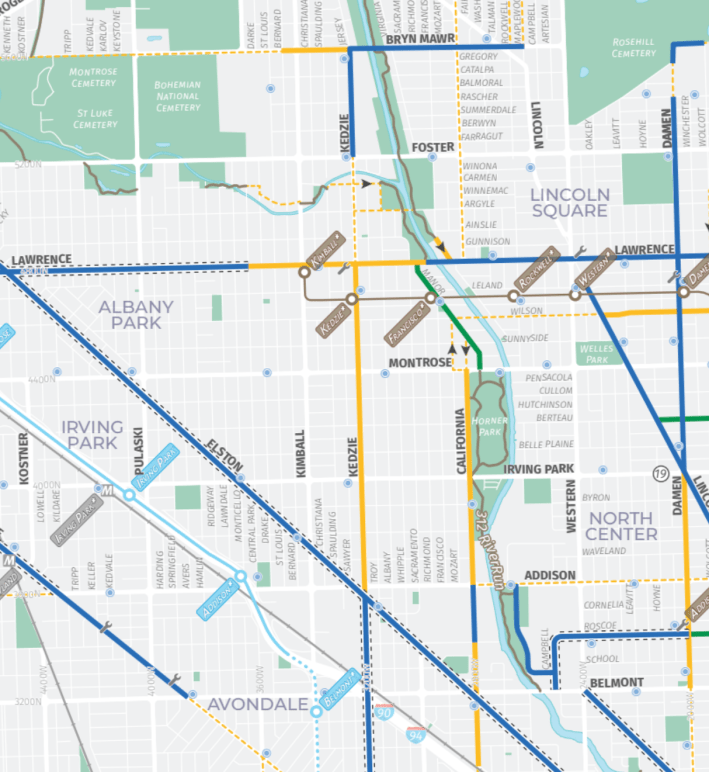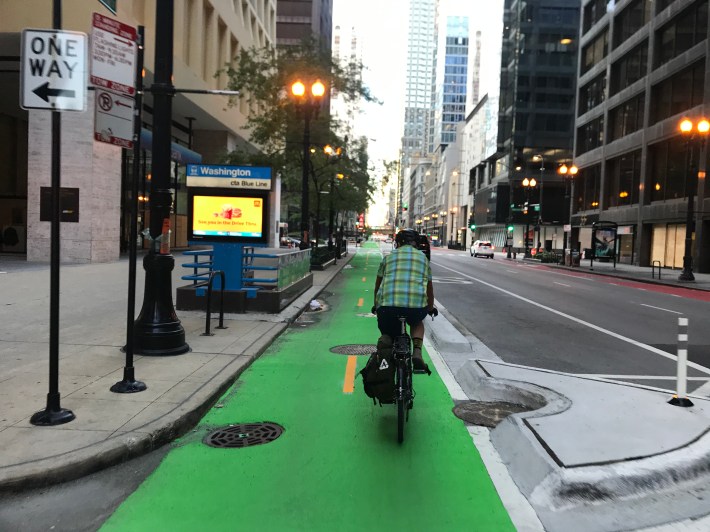Earlier this week 33rd Ward alderwoman Rosanna Rodríguez announced on Facebook that Kedzie Avenue (3200 W.) between Foster (5200 N.) and Elston (3600 N.) avenues within her ward will be repaved and will get new non-protected bike lanes, 14 red stamped crosswalks, and dozens of curb bump-outs.
Most of this stretch currently has faded "sharrows," bike-and-chevron street markings. The new bike lanes will link up with buffered lanes on Elston and non-protected lanes on Kedzie north of Foster.

33rd Ward residents initially voted in a participatory budget election for bike lanes on Kimball Avenue (3400 W.), a street two blocks west of Kedzie that has no bike facilities, but the Chicago Department of Transportation determined Kimball was too narrow for bike lanes. According to Rodríguez, neighbors also advocated for lanes on Kedzie as an alternative, so she reallocated ward "menu" infrastructure funds for that purpose. The stamped crosswalks, which are intended to be more visible to drivers and more aesthetic than standard striped crosswalks, were also bankrolled in the PB election.
The new Kedzie bike lanes will represent a modest improvement over the existing sharrows, which some have argued are worse than nothing at all. The lanes will help organize the street a little better, and remind drivers to keep an eye out for people riding bikes.
But as many Streetsblog readers know, painted bike lanes, especially ones that don't even have striped buffers, won't do much to encourage "normal" Chicagoans, people who aren't already fairly comfortable riding in traffic, to replace car trips with bike journeys. These lanes are located in the "door zone," where bike riders, especially non-confident ones, are at risk of careless motorists opening a car door in their path.
Streetsblog Chicago asked our Twitter followers what they think of the Kedzie bike lane plan. Some said the non-protected bike lanes will make their commutes better. "[I] ride on Kedzie in its current state so this is going to be a huge improvement," responded Jessica Cabe. "When they squeezed in painted bike lanes on Kedzie south of North [on the west side of Humboldt Park] recently, it drastically improved my experience. Paint’s not great but I’ll take it."
"Obviously I wish they were real [protected] bike lanes but this extends a really important north-south transit corridor for bikers to connect Albany Park to Logan Square," said another commenter. "Really ties together a lot of NW biking routes."

But others posted that the non-protected bike lanes a disappointing half-measure. "A missed opportunity to effect real change/safety on a great north-south connector route," responded one person. "Kedzie is too narrow for traffic lanes, painted bike lanes and parking – there won't be enough space for drivers to leave three feet when passing, or for people biking to stay out of door zones."
Sustainable transportation and equitable urban planning advocate Omari Bektemba tweeted that the corridor treatment represents a "great upgrade for crossing the street on foot, [but it's] weak for bikes, scooters etc."
In a longer comment on the alderman's Facebook post, Bektemba proposed installing a two-way protected bike lane on on side of Kedzie, which he argued could be done without stripping a significant amount of car parking. He argued that it's a shame CDOT didn't go bolder here, since Kedzie would be a relatively easy street to do this on because this stretch doesn't have bus stops to work around. "There are some great people at CDOT, but seeing so many other DOTs being smarter and more equitable with fewer resources is really grinding away my confidence in CDOT’s organizational competence."

My take on the issue? My preference for many arterial routes is to eliminate car parking (i.e. storage of private property on the public way) and install protected bike lanes and/or bus lanes, depending on the width of the street. Metered parking spots should be relocated to side streets, using a diagonal parking layout if necessary.
Given that half of all car trips in Chicago are under five miles, the addition of protected bike lanes on arterial roads, which would do much more to make cycling an appealing option for everyday Chicagoans, could eliminate some of these brief car trips and replace them with bike trips. Bus priority and an increase in bus frequency could also help eliminate some car trips.
Since the city of Chicago generally creates (mostly non-protected) bike lanes and bus-priority zones in a piecemeal fashion, it’s unsurprising that many Chicagoans don’t feel compelled to convert trips from driving to active transportation. Until protected bike lanes with robust physical protection to keep drivers out, protected intersections, and bus priority become the standard on our streets, car dominance will remain unchecked, people on bikes will remain unsafe, and bus riders will continue to get the short end of the stick. We can and must change this.





